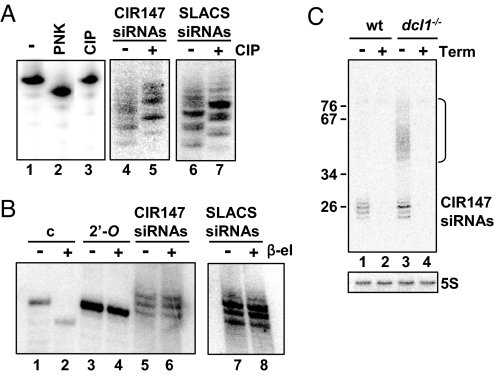Fig. 1.
Retroposon- and repeat-derived siRNAs have modified 5′ and 3′ termini. (A) A synthetic 30-nt RNA (lane 1) was sequentially treated with T4 polynucleotide kinase (PNK, lane 2) and calf intestinal alkaline phosphatase (CIP, lane 3), separated in a denaturing gel and visualized by hybridization with a complementary oligonucleotide. Small RNAs from wild-type cells were separated in a denaturing gel without (lanes 4 and 6) or with (lanes 5 and 7) CIP treatment and probed for CIR147 siRNAs (lanes 4 and 5) or SLACS siRNAs (lanes 6 and 7). (B) A synthetic 23-nt unmodified RNA (c, lanes 1 and 2), a synthetic 23-nt 2′-O-methyl oligonucleotide (2′-O, lanes 3 and 4), and small RNAs from wild-type cells (lanes 6 and 8) were subjected to periodate oxidation/β-elimination and probed for CIR147 siRNAs (lanes 5 and 6) or SLACS siRNAs (lanes 7 and 8). (C) Small RNAs from wild-type (wt) and dcl1KO cells (dcl1−/−) were treated with Terminator exonuclease and subjected to Northern analysis for the CIR147 siRNAs. 5S rRNA (5S), which harbors a 5′-triphosphate terminus, served as a control.

